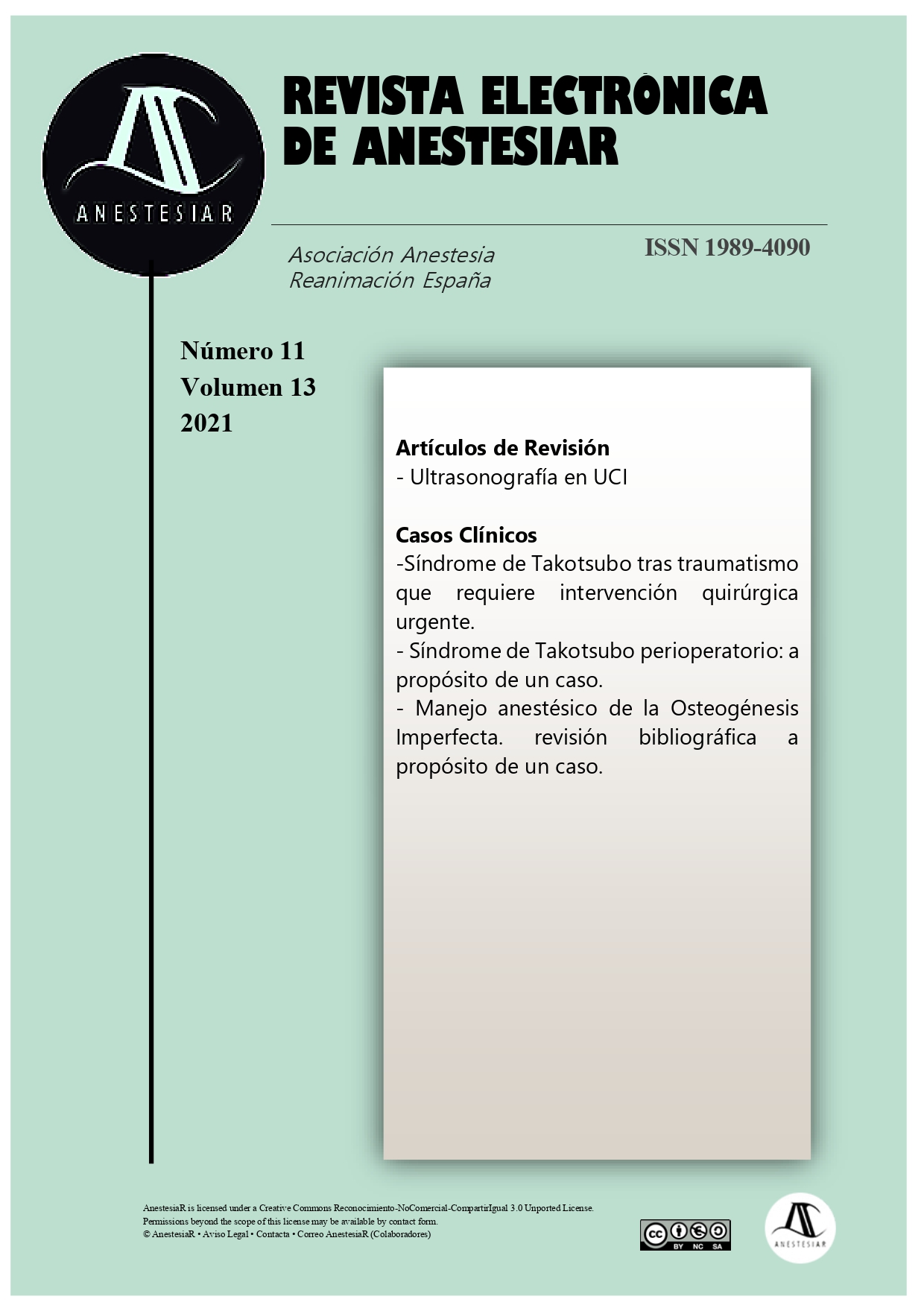Perioperative Takotsubo syndrome: case report.
DOI:
https://doi.org/10.30445/rear.v13i11.1028Keywords:
Takotsubo Cardiomyopathy, Perioperative Period, Anesthesia, SurgeryAbstract
Up to 10% of patients with ST-segment elevation myocardial infarction do not have obstructive coronary lesions, MINOCA, from the acronym in English. The diagnosis of MINOCA is functional and includes causes such as type II acute myocardial infarction, dissection, coronary spasm and embolism, myocarditis, and Takotsubo syndrome. Takotsubo syndrome is a pathology with its own entity, characterized by a transient and reversible dysfunction of the left ventricle without coronary obstructive lesions. It usually has triggers that cause an excess of plasma catecholamines. Its form of presentation during the intervention can be in the form of hypotension, shock or arrhythmias. In the acute phase it can be serious and present serious complications. The first-line imaging test is echocardiography. Management is symptomatic of the complications that may appear, avoiding catecholaminergic drugs.
References
- Ghadri JR, Wittstein IS, Prasad A, et al. International Expert Consensus Document on Takotsubo Syndrome (Part I): Clinical Characteristics, Diagnostic Criteria, and Pathophysiology. Eur Heart J. 2018;39(22):2032-2046. doi:10.1093/eurheartj/ehy076
- Yamel Ache, Carlos Guamán, Lorena Viñole, Gustavo Vignolo. Infarto agudo de miocardio sin lesiones coronarias obstructivas – MINOCA : un enigma para el cardiólogo clínico .Rev Urug Cardiol 2020; 35:77-86. doi.org/10.29277/cardio.35.1.11
- Agarwal S, Sanghvi C, Odo N, Castresana MR. Perioperative takotsubo cardiomyopathy: Implications for anesthesiologist. Ann Card Anaesth. 2019;22(3):309-315. doi:10.4103/aca.ACA_71_18
- Agarwal S, Bean MG, Hata JS, Castresana MR. Perioperative Takotsubo Cardiomyopathy: A Systematic Review of Published Cases. Semin Cardiothorac Vasc Anesth. 2017 Dec;21(4):277-290. doi: 10.1177/1089253217700511
- Gupta S, Gupta MM. Takotsubo syndrome. Indian Heart J. 2018 Jan-Feb;70(1):165-174. doi: 10.1016/j.ihj.2017.09.005
- Hessel EA 2nd. Takotsubo cardiomyopathy and its relevance to anesthesiology: a narrative review. Can J Anaesth. 2016 Sep;63(9):1059-74. English. doi: 10.1007/s12630-016-0680-4
- Jothin A, Raj JP, Thiruvenkatarajan V. A simple procedure in a complex patient: perioperative takotsubo cardiomyopathy. BMJ Case Rep. 2020 Dec 17;13(12):e233121. doi: 10.1136/bcr-2019-233121
- Citro, R., Okura, H., Ghadri, J. et al. Multimodality imaging in takotsubo syndrome: a joint consensus document of the European Association of Cardiovascular Imaging (EACVI) and the Japanese Society of Echocardiography (JSE). J Echocardiogr 18, 199–224 (2020). https://doi.org/10.1007/s12574-020-00480-y
- Ghadri JR, Wittstein IS, Prasad A, et al. International Expert Consensus Document on Takotsubo Syndrome (Part II): Diagnostic Workup, Outcome, and Management. Eur Heart J. 2018;39(22):2047-2062. doi:10.1093/eurheartj/ehy077
-Moscatelli S, Montecucco F, Carbone F, et al. An Emerging Cardiovascular Disease: Takotsubo Syndrome. Biomed Res Int. 2019;2019:6571045 doi.org/10.1155/2019/6571045.
Downloads
Published
How to Cite
Issue
Section
License
Copyright (c) 2021 Revista Electrónica AnestesiaR

This work is licensed under a Creative Commons Attribution-ShareAlike 4.0 International License.
 Envío y derechos de autor
Envío y derechos de autor


 Revista Electrónica AnestesiaR by
Revista Electrónica AnestesiaR by 